| Introduktion
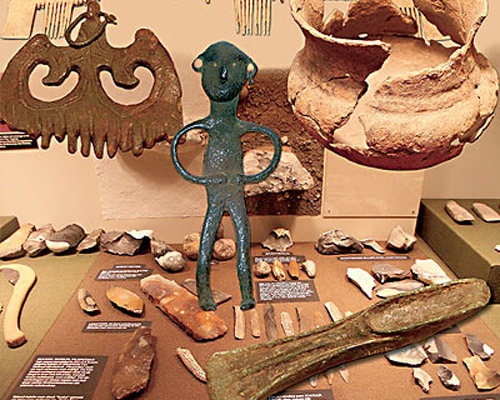
| | Oldtiden i Skandinavien er betegnelsen på den tidsperiode, som ligger før middelalderen. Det er desuden en periode, hvor der ikke findes skriftlige kilder; vi må i stedet se på og fortolke de arkæologiske fund.
Til forskel fra middelalderen, hvor det meste af kildematerialet ligger i arkiver, må vi begive os til museerne for at få et nærmere indblik i vores fortid. |
De fleste egne i det nuværende Danmark og Skåne har i Oldtiden været dyrket og bebygget siden isen begyndte at trække sig tilbage for ca. 15.000 år siden. I Øresundsregionen er der bevaret utallige synlige spor fra denne tidlige periode i menneskets historie.
Takket være traditionen for et tværfagligt samarbejde mellem naturvidenskab/ arkæologi og historie i både Danmark og Sverige har man et ganske godt overblik over vores fælles fortidshistorie.
En dybere indsigt kræver dog et vist overblik over hvilke betegnelser, man normalt bruger om Oldtiden. Normalt deles denne op i tre hovedperioder:
- Stenalder
- Bronzealder
- Jernalder
Men der foregår enorme forandringer inden for de mange tusinde år. For at få styr på dette bruger man ofte, i nuværende Danmark, nedenstående benævnelser inden for hver hovedperiode:
| Ældre stenalder/Jægerstenalder: | Ca. 12.000 f. Kr. - ca. 4.000 f. Kr. | | Maglemosekulturen | Ca. 9000 f. Kr. – 6.800 f. Kr.
| | Kongemosekulturen | Ca. 6.800 f. Kr. – 5.400 f. Kr.
| | Ertebølkulturen | Ca. 5.400 f. Kr. – 3.900 f. Kr. |
| Yngre stenalder/Bondestenalder: | Ca. 4.000 f. Kr. - ca. 1.800 f. Kr. | | Tidlig-neolitisk tid | Ca. 3.900 f. Kr. - 3.300 f. Kr.
| | Mellem-neolitisk tid | Ca. 3.300 f. Kr. – 2.800 f. Kr. | | Enkeltgravstid | Ca. 2.800 f. Kr. – 2.400 f. Kr. | | Sen-neolitisk tid | Ca. 2.400 f. Kr. – 1.700 f. Kr.
|
| Bronzealder: | Ca. 1.800 f. Kr. – 500 f. Kr.
| | Ældre bronzealder | Ca. 1.700 f. Kr. – 1.000 f. Kr.
| | Yngre bronzealder | Ca. 1.000 f. Kr. – 500 f. Kr.
|
| Jernalder: | Ca. 500 f. Kr. – 1.100 e. Kr.
| | Førromersk jernalder | Ca. 500 f. Kr. - 0
| | Romersk jernalder | Ca. 0 – 450 e. Kr.
| | Germansk jernalder | Ca. 450 e. Kr. – 750 e. Kr.
| | Vikingetid | Ca. 750 e. Kr. – 1100 e. Kr. |
Stenalderen
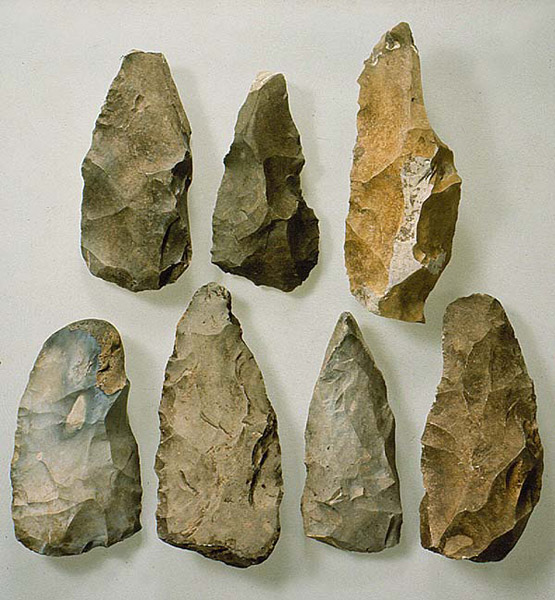
| | Stenalderen er betegnelsen for perioden ca. 12.000 f.Kr. til peroden ca. 1800 f.kr.
Den lange periode deles ofte op i ældre og yngre stenalder.
Flinten var det mest benyttede arbejdsredskab og våben.
Flintøksefundene er oftest fra yngre stenalder. Foto: Fotevik Museum |
Ældre stenalder
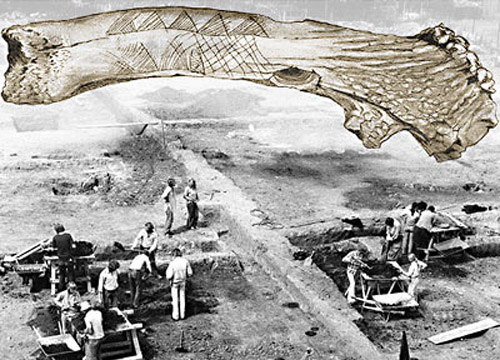
| | Den ældre stenalder strækker sig fra ca. 12.000 år f.Kr frem til ca. 4.000 år f.Kr.
Kendetegnende for perioden er, at der levede et relativt begrænset antal mennesker i Øresundsregionen samt at disse mennesker ikke var bofaste i den betydning, at de dyrkede jord. |
Indledning
Den ældre stenalder strækker sig fra ca. 12.000 år f.Kr. frem til ca. 4.000 år f.Kr. Kendetegnende for perioden er, at der levede et relativt begrænset antal mennesker i Øresundsregionen, og at disse mennesker ikke var bofaste og dyrkede jord.
Under denne tidsperiode forandredes både klimaet og naturen i Skandinavien. De første jægerfamilier mødte et arktisk klima med et tundralignende landskab, medens familierne under periodens senere del levede i store og tætte skove fyldt med vilde dyr.
Nogle af de ældste spor efter mennesker i Øresundsregionen er de stenalderfund, der blev gjort ved Mölleröd tæt ved Finjasøen i det nordlige Skåne. Her har rensdyrjægere efterladt sig bearbejdet flintsten især i form af pilespidser.
Et andet fund fra vores ældste forfædre kommer fra Segebro i Malmøs nordlige udkant. Denne boplads er dateret til ca. 8.300 f. Kr.
Segebro
Segebro ligger i Malmøs nordlige udkant. I en kortere periode har én eller flere rensdyrjæger-familier ca. 8000 f.Kr. slået sig ned her for at jage. De har efterladt sig et stort antal bearbejdede flintsten, som har været benyttet til forskellige redskaber. Det har ikke været nogen stor lejrplads, men man har fundet spor efter et stort telt.
Man har også fundet to steder, hvor renjægerne har siddet og flækket flintstene til skrabere, knive og pilespidser. Her lå dynger af halvfærdige redskaber. Med runde slagstene har man slået fliser –spån- ud af større flintblokke. Disse aflange spån har man herefter bearbejdet yderligere. En del er blevet til kraftige spidser, der har kunnet anvendes til våben. Andre har fået en skarp kant, så de kunne bruges som skrabere.
Disse første Malmøboere var nomader. Dyrene, man jagede, udgjorde selve livsgrundlaget. Af rensdyr og elge, fik man kød, men også skind til klæder, telte, transportemballage og meget mere. Dyrenes sener blev til sytråd; knogler og horne blev til arbejdsredskaber. Teltene var af dyrehuder; kvinderne tilberedte det kød, som mændene efter vellykkede jagter slæbte hjem til lejren. Med flintredskaberne bearbejdede man huder, træ og dyrenes horn og knogler.

Segebro |
Bopladser under vandet
I den ældre stenalder var vandstanden i det sydlige Skandinavien betydeligt lavere end i vore dage. Dette forklarer f.eks. hvorfor der står mængder af fyr-træstubbe dybt nede på Østersøens bund. Bornholmske fiskere har i hele 1900-tallet fået træstubbe fra både 30 og 80 meters dybde i deres net; et klart bevis på, hvor lavt vandoverfladen en gang stod. Øresund var, under det meste af den ældre stenalder, kun et smalt vandområde med en række større og mindre øer.
Temperaturen stiger og isen smelter:
I forbindelse med at temperaturen, globalt set, steg, smeltede store ismasser og verdenshavenes overflade steg. I perioden 7.500 f. Kr. til ca. 6.000 f.Kr. steg Øresunds vandoverflade således med 15 meter. For, godt og vel, syvtusinde år siden stod vandoverfladen på nutidens niveau.
Men vandstanden steg yderligere til næsten tre meter over nutidens niveau i Øresund. Efterhånden trak vandet sig tilbage og dannede den kystlinie, vi kender i dag.
På Øresunds bund findes der derfor adskillige stenalder-bopladser.
Fundet ved Limhamn:
Et eksempel på en sådan jægerstenalder-boplads er fundet fra Limhamn. Da man gravede mudder op ved Limhamns havn i 1891, fulgte der både græstørv og bearbejdet flint med. Bl.a. 13 stenøkser.
Fundet kom fra boplads fra 5000 f Kr. på to-tre meters dybde under Øresunds nuvarende vandoverflade.
Fundet ved Hven:
En anden ”underjordisk” boplads i Øresund er fundet nær øen Hven. På det nærliggende fastland, lidt syd for øen, ligger byen Landskrona, hvor en å, Saxåen, i dag løber ud i Øresund. Da vandet i Øresund stod langt lavere end i dag løb åen ud ved Hven. Af denne tidligere å ser man i dag en dyb rende på bunden af Øresund.
Ved at undersøge å-ravinens sider har dykkere kunnet spore flere skjulte bopladser. En af disse ligger på grunden Pilhaken.
Fra et bundniveau syv meter under vandoverfladen går den tidligere å-ravine stejlt nedad til 14 meters dybde. På ravinens kanter fandt arkæologerne rester efter en boplads. De forskellige overleveringer lå søbet ind i et tykt lag af slam. Der var tale om mængder af flintafslag, flintskrabere og andre flintredskaber. Knogler fra urokse, kronhjort og rådyr viste, at disse vore tidlige forfædre, ikke blot ernærede sig ved fiskeri.
Fundet ved Espergærde, Nordsjælland:
Umiddelbart foran Egebæksvang Kirke på Strandvejen i Espergærde har dykkere i nyere tid observeret en boplads under havoverfladen.

Egestamme |
Skateholm og Vedbæk
I Skateholm ved Skånes sydkyst, lige øst for Trelleborg, findes en af de største kendte bosættelser i Sydskandinavien fra den yngste del af den ældre stenalder, ca. 5.600 f. Kr. til ca. 4.700 f. Kr.
Udover spor efter enkle hyttekonstruktioner har man fundet en mængde grave. Bopladsen er nogenlunde samtidig med den boplads, som danske arkæologer afdækkede i Vedbæk på den danske side af Øresund.
Tilsammen giver disse to bopladser en uvurderlig information om datidens mennesker og deres livsvilkår.
Vedbækfundet er udstillet på G. Holtegård, Sjælland, mens Skateholmsfundet kan beses på Trelleborg Museum, Skåne.

Skateholm I | 
Skateholm II | 
Rekonstruktion af hytte |
Bergmandsdal ved Helsingør
I 1955 opdagede en husejer på Sdr. Strandvej 52. d, syd for Helsingør, spor efter en af Øresundsregionens mange bopladser fra ca. 5.000 år f. Kr.
Arkæologiske udgravninger på fundstedet afdækkede bl.a. tre menneskeskeletter, fem hundeskeletter og en del flintøkser, hjortetaksøkser og skafter til disse af samme materialer. Både hjortetaksøkserne og skafterne var smykkede med geometriske mønstre, som var fælles for jægergrupperne i Sydskandinavien.
Af det samlede fund fremgår det, at stenalderjægerne på stedet har levet af fiskeri og jagt i de store bagvedliggende skove. I skovene har de jagtet hjortevildt, svin, pelsdyr og fugle.

Hjortetaksøkse | 
Ornament på øksen | 
Hjortetaksskaft |
Yngre stenalder
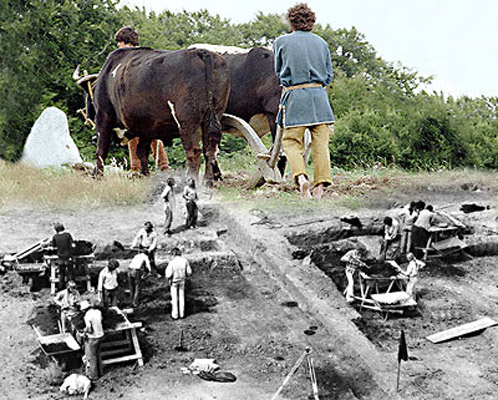
| | Dette tidsafsnit af vores nordiske fortid strækker sig fra ca. 4.000 f. Kr. frem til ca. 1.800 år f. Kr.
Agerbruget blev langt mere almindeligt, og bopladserne mere permanente. |
Indledning
Dette tidsafsnit af vores nordiske fortid strækker sig fra ca. 4.000 f. Kr. frem til ca. 1. 800 år f. Kr.
Kendetegnende er, at agerbruget vandt frem og befolkningen blev derfor mere bofast end tidligere; hermed skete der også en ændring af måden menneskene levede og boede sammen på. Arbejdsredskaberne, flintøkserne, forandredes og nye opbevaringsmåder blev nødvendige, f.eks. keramikkrukkerne. I stedet for en befolkning, der fortrinsvis levede af jagt og fiskeri, blev det nu afgrøderne fra det voksende jordbrug, der kom til at blive det bærende eksistensgrundlag. Perioden kaldes derfor også, med rette, for Bondestenalderen.
Bondestenalderen deles normalt op i tre tidsafsnit, som arkæologerne betegner:
-Tidligneolitikum
-Mellemneolitikum
-Senneolitikum
Megalitgravene/Storstensgravene
Periodens gravskikke betyder bl.a., at der i Øresundsregionens kulturlandskab endnu er markante spor efter disse tidlige og driftige bønder i form af storstensgrave. De såkaldte dysser og jættestuer. Tilsammen kaldes de for megalitter.
I dagens Danmark kendes omkring 6.000 stendysser og 700 jættestuer, men ofte er det dog kun resterne af dem, man kan se.
Kvalificerede beregninger anslår, at der oprindeligt har været 20-25.000 af disse megalitter i perioden 3.500-3.200 f.kr..(Jf. Odense Museum)
Traditionelt daterer man normalt stendysserne til tidlig neolitikum og jættestuerne til mellemneolitikum, men de to megalitter hører dog uløseligt sammen.
Storstensgravene blev i flere hundrede år benyttet først som enkeltmandsgrave (til Høvdinge?) og senere som lokalområdets fælles gravplads.
Langhøje
En speciel type af grave, de såkaldte ”langhøje” var en slags forløbere for det egentlige dyssebyggeri. De er dateret til den ældste del af bondestenalderen - altså den del, der betegnes som tidlig-neolitikum.
Langhøjene kan virke meget imponerende, selvom højden ofte kun er nogle få meter. Bredden er under 10 meter, men længden kan være ganske betydelig. Langhøjene er de første monumentale fortidsgrave over jordlaget, som vi kender. Til forskel fra de senere langdysser er selve gravkammeret ikke opbygget af sten, men af træ. Det som udefra kendetegner en langhøj er imidlertid, at hele det aflange, rektangulære gravområde er afgrænset af oprejste sten/randstene.
Et eksempel på en sådan langhøj er den såkaldte ”Jättegrav” ved Trelleborg i Skåne. Her er der ca. 60 stene omkring gravområdet tilbage, men i stenalderen har der ganske givet været mindst det dobbelte. Graven er kun ca. fem meter bred, men er til gengæld hele 64 meter lang. Dette gør den til den største af sin slags i Sverige.
Runddysser
Dysser er stenkammergrave, hvor man på store støttesten placerer en større stenblok. Blandt dysserne skelner man –alt efter form- mellem runddysser og langdysser. Mellemrummene mellem de store sten har man udfyldt med mindre sten lagt oven på hinanden.
I nutiden ser man ofte dysser, som er helt fritstående. Sådan var det ikke i fortiden. Da lå disse gravkamre næsten helt skjult under et lag af opkastet jord.

Skegridyssen | 
Gantoftedyssen | 
Dysse ved Höör i Skåne | 
Klosterris Hegn i Nordsjælland |
Langdysser
Ofte dannede højens kanter en kvadratisk platform markeret med randstene. Resterne efter en langdysse er bl.a. gravet ud i Fosie udenfor Malmø. I 1980´ erne blev den rekonstrueret i Skånes Dyrepark tæt ved Höör i midten af Skåne.
I Nordsjælland, ved Trollesminde tæt ved Hillerød, fandt man i 1855 en af Danmarks største langdysser: ”Rokkestenen”. Langdyssen er 40 meter lang og 25 meter bred og består af et kisteformet gravkammer, som er omkranset af en række randsten, hvoraf nogle af dem er ca. to meter høje. Taget på langdyssen, dækstenen, måler ca. to gange tre meter og vejer skønsmæssigt 12-14 tons.
Under udgravningen af den kolossale dæksten opdagede man, at stenen kunne rokkes frem og tilbage. Således fik ”Rokkestenen” sit navn.
Hillerød Kommune har i 2007 i samarbejde med Nationalmuseet ryddet området omkring fortidsmindet, så man på marken mellem Peder Oxes Allé og motortrafikvejen kan glæde sig over synet.

Langdysse ved Hillerød |
Jættestuer
Jættestuerne er et rektangulært eller ovalt gravkammer ofte benyttet som kollektiv gravplads. De er opført inden for et relativt kort tidsafsnit og hører i Danmark tidsmæssigt til omkring mellemnolitimun ca.3.200 f.Kr.
Jættestuerne er en arkitektonisk videreudvikling af dysserne forstået på den måde, at selve gravkammeret nu er vældig stort og har flere dækstene. For at komme ind til gravkammeret skal man igennem en 4-6 meter lang og trang gang. Der findes desuden jættestuer med to gravkamre.
På den skånske side af Øresund findes to velbevarede jættestuer, dels ved Barsebäck, dels ved Ålabodarna. Begge disse stenaldergrave kan man krybe ind i. Husk at tage en lommelygte med!
På den danske side af Sundet findes der, bl.a. ved Roskilde, en velbevaret jættesstue, hvor der er adgang året rundt. Og i skovene og på markerne i Helsingør Kommune er der mange, mere eller mindre, velbevarede spor efter både dysser og jættestuer.

Jættestuen i Gillhög |
Flintøkser
Flintøksen er et redskab, som i allerhøjeste grad forbindes med bondestenalderen. Det krævede kraftige økser at fælde de store træer, først og fremmest løvtræer, der godt 3.000 år f. Kr. dannede store og tætte skove i landskabet.
Kerneøkserne
Man kendte godt til flintøkser i jægerstenalderen, men disse var lette og kunne ikke benyttes til at fælde store træer med. Jægernes flintøkser var såkaldte ”kerneøkser”, som var temmelig groft formet og tilhugget fra en mindre, aflang flintsten. Man havde også såkaldte ”skiveøkser”, som man skabte ved at spalte en større flintblok.
De spidsnakkede økser
Under tidligneolitisk tid, ca. 3.900 f.Kr. – ca. 3.300 f.Kr., begyndte de slebne flintøkser at dukke op i Sydskandinavien. Først kom de såkaldte ”spidsnakkede” økser. Øksetypen er fundet i store mængder just i Skåne og på Sjælland. Allerede i slutningen af 1800-tallet påpegede den legendariske svenske arkæolog Montelius, at denne type var den ældste af de ældste slebne flintøkser. Den spidsnakkede økse var helslebet og jævnt tilspidset mod nakken. Den har ingen smalle sider, øksens to hvælvede sider møder i stedet hinanden i en skarp kant.
De tyndnakkede økser
I mellemneolitisk tid dukker der en helt ny type af flintøkser op. De er ofte betydeligt større og frem for alt længere. De kaldes for ”tyndnakkede”. De er flade og smaller ind mod nakken. Længden kan variere fra 15 cm. og helt op til 40 cm.
Forandringen af flintøksetypen fra spidsnakkede til tyndnakkede større økser må have haft et bestemt formål, skovrydning. Med de større økser havde man nu fået et effektivt redskab til at rydde skovene, så landbrugsjorden kunne udvides.
Stenaldermennesket havde på denne tid åbenbart taget landskabet i sin besiddelse.

Kerneøkser | 
Flintværktøj |
Keramik
Et andet bevise på, at det tidligere jægersamfund gik over til at blive mere bofast i den tidligneolitiske tid er den rige forekomst af keramik fra perioden. Keramik er skrøbeligt og egner sig ikke til jægersamfundets omstrejfende tilværelse.
Tragtbægerkulturen
Et karakteristisk træk for efterladte bopladser fra den tidligneolitiske tid er de mange keramikfund af en aldeles speciel type, de såkaldte ”tragtbægre”. Af navnet fremgår det, at keramikken har form af et bæger med en hals. De ældste tragtbægre er ofte temmelig klodsede beholdere. Men de mennesker, der har anvendt dem, må have været bofaste; bestemt ikke folk, der bestandigt var på farten. Tragtbæger-keramikken kan derfor betragtes som en hilsen fra de første bønder i Skåne og på Sjælland.
Allerede i denne tidlige form for keramik ser vi menneskets trang til kunstnerisk udfoldelse. Det våde ler var og er et fortræffeligt materiale, dels ved selve formgivningen, men også ved dekorering. En interessant iagttagelse er det, at den sparsomme dekorering af bægrene er næsten ens på begge sider af Sundet, hvilket tyder på, at der har været nære kontakter mellem befolkningen i Øresundsregionen.

Stenalderkeramik |
Bronzealderen

| | Bronzealderen strækker sig fra ca. 1800 til ca. 500 f.Kr. Perioden har sat sig særdeles tydelige spor i Øresundsregionens landskab , hvor bronzealderens mange gravhøje skyder op på markerne.
Fra perioden er der fundet store mængder af smukt forarbejdede bronzegenstande. Flere af dem indgår som markante, symbolske udtryk for den danske kulturarv. F. eks. Solvognen og musikinstrumenter som lurer. |
Indledning
Perioden ca. 1800-500 f.Kr. bliver i nordisk historie kaldt bronzealderen, fordi
redskaber, våben og smykker, for det meste, blev lavet af bronze.
I bronzealderen ses de første tegn på en lagdeling af samfundet med markant social ulighed. Det er tydeligt, at det var de rigeste, som blev begravet i de kunstige gravhøje på de mest synlige steder i landskabet. Bronzealderen blev kendetegnet ved en kultur, der er præget af rige gravgaver i de talrige høje. Den større befolkningstæthed og det, at man skrællede betydelige arealer for græstørv til gravhøjene, medførte et øget pres på naturressourcerne. Det milde klima og de store arealer med urørt skov betød dog, at man stadig kunne brødføde alle.
I nutidens øjne kendetegnes Bronzealderens ældste del først og fremmest ved, at den, i form af disse gravhøje, har efterladt sig yderst håndgribelige, synlige spor i kulturlandskabet. Gravhøjene er mest fremtrædende i Jylland, men er også særdeles synlige fortidslevn i Skåne og på Sjælland. Ét af de bedst bevarede fund fra den ældre bronzealder er Egtvedpigen i ”Storhøj” ved Egtved i Jylland og Skrydstruppigen i Sønderjylland.
Det er også i bronzealderen vi, via helleristningerne, får et godt indblik i datidens rige billedverden. I Øresundsregionen ser vi dem bl.a. i Skåne på Österlen, i det nordøstlige Skåne og på Bornholm.
Blandt de mange bronzefund er der kunstfærdigt fremstillede, religiøse genstande. Bl.a. ét af Danmarks nationalsymboler, Solvognen, der blev fundet i Nordsjælland. Blæseinstrumenter som f.eks. en lur er der fundet mange af; især i Danmark og på Rådhuspladsen i København ser man en statue af to lurblæsere fra bronzealderen. Statuen er fra 1911.
Ved bronzealderens overgang til germansk jernalder dukker de første bindningsværkshuse op. Tidligere tiders byggeskik, hvor væggene massivt var bygget op af tømmer/planker, blev nu ofte erstattet med enkle trærammer og inden for disse, byggede man nu væggene op med ler. I nærheden af bopladser fra denne tid, finder man derfor ofte store lerudgravninger. Disse er senere blevet fyldt op med affald.Gravhøje
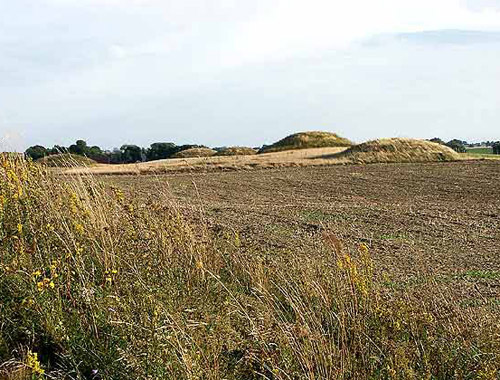
| | Den største gravhøjsmark i Øresundsregionen, ja faktisk i hele Norden, findes i Steglarp ved Vellinge syd for Malmø.
I dag er antallet af gravhøje kraftigt reduceret.
|
Bronzealderens gravhøje
En gravhøj også kaldet en kæmpehøj er en begravelsesplads, bestående af jord, sten eller begge dele. Der findes flere typer gravhøje. De kan være runde eller lange i form. Højden varierer meget. De højeste gravhøje kan være op til 20 meter høje.
Den største kæmpehøjsmark i Øresundsregionen, ja faktisk i hele Norden, findes i Steglarp ved Vellinge syd for Malmø. I dag er de fleste af gravhøjene dog fjernet eller stærkt reduceret i højden. Men de enorme byggeprojekter, der i omfang kan sammenlignes med middelalderens kirkebyggeri, kan anskueliggøres ved, at der alene i Skåne, anslås, at der har været mere end 5.000 af disse gravhøje. I dag findes der dog ca. 2000 bevaret. Et kort over tilbageværende gravhøje i Skåne viser, at de fortrinsvis ligger i kystområderne og ved de større sejlbare åer.

Steglarp | 
Skånes største gravhøj | 
Gravhøjskort fra Skåne |
Gravhøjenes datering
Fra gravhøje i Jylland har man opnået sikre årringsdateringer -videnskaben om dette kaldes dendrokronologi - , som fortæller, hvornår højene blev opført. Disse årstal ligger forbavsende tæt på hinanden. Nedenfor ses listen over resultatet af årringsdateringen fra egetræskisterne, der blev fundet i gravhøjene. De årstal som ikke er nøjagtige kan variere med +/- 25 år.
Trindhøj ca 1330 f.Kr.
Trindhøj ca 1333 f.Kr.
Trindhøj ca 1356 f.Kr.
Borum Eshøj ca 1345 f.Kr.
Borum Eshøj ca 1353 f.Kr.
Egtved 1370 f.Kr.
Lille Dragshøj ca 1370 f.Kr.
Storehøj i Barde 1373 f.Kr.
Guldhøj ca 1381 f.Kr.
Guldhøj ca 1381 f.Kr.
Mølhøj i Uge ca 1396 f.Kr.
Eftersom trækisterne tilhører tidspunktet for anlæggelsen af gravhøjene, kan det konstateres, at højene er opført inden for en yderst begrænset periode, der kun dækker to generationer.
Med sig til dødsriget har de døde fået mad og drikke, men også kostbarheder såsom smykker og våben. Sammenlignet med begravelsesskikkene i stenalderen er dette en helt ny begravelsesskik. Denne ændring, tilsammen med den korte tid, indikerer at der måske har eksisteret en form for dynasti, som har domineret datidens samfund.
Egtvedpigen
I gravhøjen ”Storhøj” i Jylland gjorde man i 1921 et bemærkelsesværdigt fund. Fra gravhøjen, der ligger ved landsbyen Egtved lidt syd for Vejle, dukkede der ved udgravningen en to meter ”træ-stokskiste” af egetræ frem. En dendrokronologisk undersøgelse viste, at kisten var fra ældre bronzealder, ca.1.370 år f.Kr.
Den døde var en ung kvinde på 16-18 år og ved pigens fødder, havde man lagt en tøjbylt med de brændte knogler af et 5-6 årigt barn. Ved pigens hoved lå der desuden en lille æske af birkebark med mindre knogledele fra det samme barn.
Egtvedpigen lå på en kohud og var dækket af et uldent tæppe. Egtvedpigen, der i dag ligger på Nationalmuseet i København, omtales som et af Danmarks bedst bevarede bronzealderfund, skønt pigens hud og kropsdele er helt borte, Alligevel er gravhøjsfundet unikt, for pigens klædedragt var meget velbevaret.
Klædedragten
Overkroppen var dækket af en kortærmet trøje med halvlange ærmer. Trøjen var stumpet, så den efterlod en del af maven bar. En nøgenhed der yderligere fremhævedes ved, at den lårkorte kjole hang langt nede på hofterne. Kjolen var dannet af et snoreskørt, og om midjen havde hun et vævet bæltet, hvor en bronzebælteplade med spiralmønster var monteret. I bæltet sad desuden en kam af horn. På begge arme sad der armringe, og hun havde en ørering i det ene øre. På fødderne sad der en slags tøjmokkasiner foret med græs.
Netop klædedragten giver stadig anledning til diskussion og teorier blandt forskerne. Bl.a. fordi den adskiller sig fra alle andre lignende fund fra perioden, hvor kvinderne var langt mere praktisk og tækkelig klædt på til det hårde markarbejde. Var hun en glædespige? En slavinde? Imod taler, at man da næppe havde ofret en gravhøj og et brændoffer på hende. En nærmere undersøgelse påviser at barnet næppe kan have været hendes eget.
Historieforfalskning
For datidens forskere (1920`erne) var pigens klædedragt et chok. Kunne det virkelig være rigtigt, at de unge bronzealderkvinder var gået så uanstændigt klædt? Det kunne ikke passe! Man måtte naturligvis have glemt at give hende resten af tøjet på, da man begravede hende.
I en af de første rekonstruktionstegninger af den afdøde iførte man hende derfor en anstændig fodlang kjole. Uden på kjolen placerede man så den lårkorte kjole. Nu så pigen nøjagtig ud som en husassistent i det bornerte borgerlige samfund i 1920`erne. Den udfordrende lårkorte kjole var blevet til et mere passende forklæde!

Egtvedpigen | 
Egtvedpigens lårkorte kjole |
Skrydstruppigen
I Sønderjylland, ca. 1 km fra Vojens, udgravede man i 1935 en bronzealderhøj på Skrydstrup mark. I bunden af højen fandt man en egekistegrav, hvor selve kisten dog var smuldret. Kisten havde været dækket af nogle sten, og her fandt man liget af en ung kvinde. Hun har ligget i kisten på en kohud og var iført en trøje med lange ærmer og i øvrigt svøbt i og dækket af uldent, vævet tøj. Ved siden af hovedet lå en kunstfærdigt udført hue.
Det mest bemærkelsesværdige var dog pigens frisure. Der var tale om en håropsætning i ”rokokkostil”. Et imponerende stykke arbejde som hun ikke kan have udført alene. Desuden havde hun en guldring i hvert øre.
Det rige gravfund styrker teorien om, at det er mennesker fra de højeste sociale lag, vi støder på i bronzealderens gravhøje.
Skrydstruppigen er, som den jævnaldrende Egtvedpige, udstillet i Nationalmuseet i København.

Skrydstrupspigen | 
Skrydstruppigens rekonstruerede frisure |
Helleristninger
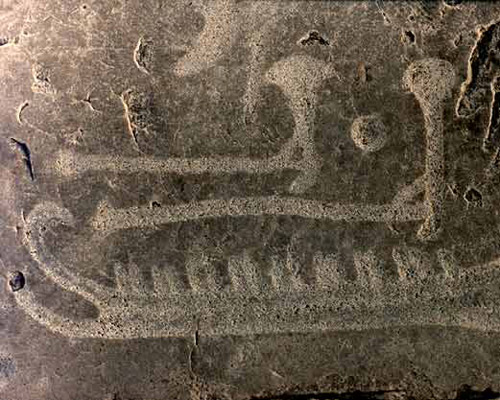
| | Helleristninger, det vil sige tegn eller billeder indhugget i sten findes i hele Sydskandinavien, men også andre steder i Europa. De dateres til at være tilhuggede i perioden yngre stenalder og bronzealderen.
I Øresundsregionen er der fundet en hel del billedhelleristninger i Simrishamn i Skåne og på Bornholm. |
Hvad er Helleristninger?
Helleristninger er billeder og tegn, som i forhistorisk tid blev indhugget og indslebet på heller, det vil sige glatte sten og klippeflader. Fænomenet kendes fra store dele af verden til forskellig tid. I Norden findes de ældste helleristninger i Norge og i Mellemsverige.
I Sydskandinavien er den overvejende del af helleristningerne udført i bronzealderen; af disse udgør skålformede fordybninger halvdelen, blandt resten dominerer stiliserede skibsbilleder. Menneskefremstillinger gengives ofte i situationer, der afspejler bronzealderens frugtbarhedskult.
Skålgrupperne
De såkaldte ”skålgruber”, runde fordybninger indhugget i sten, er den ældste form for helleristninger, vi kender, og de findes på begge sider af Øresund. Betydningen er usikker. På mange dysser og jættestuer fra yngre stenalder, bondestenalderen, kan man se skålgruber indhugget i dækstenenes overside. F.eks. i dysserne i skovene omkring Helsingør: Klosterris Hegn og Horserød Hegn.
Og på den statelige Snarringedysse ved Skegrie mellem Malmø og Trelleborg findes f.eks. ikke mindre end 268 skålgruber indhugget i en af dækstenene.
Skålgruber kan også findes på løse sten og på klippesider. I Skåne findes der mange koncentrationer specielt i landskabets nordvestre og nordøstre hjørne.
Skålgruberne kan dateres til slutningen af bondestenalderen og bronzealderen. Et af de ældste daterbare fund af skålgruber i Norden er gjort i Fosie i Malmø. En kvinde tilhørende den såkaldte ”stridsøksekultur” havde i sin grav fra 2.300 f.Kr. fået en større rund sten med to indhuggede skålgruber med sig.
Billederne
Helleristninger i form af billeder findes i store mængder nær ved Simrishamn i sydøstre Skåne samt på Bornholms nordlige del. Områderne Järrestad, Simrislund i Skåne og Allinge på Bornholm er kendte navne for folk, der interesserer sig for helleristninger. Her findes et utal af skibe, okser, fodaftryk m.m.
Tolkning af "Den dansende mand fra Järrestad"
I Järrestad findes der en helleristning af en mærkelig mand. Benene er dobbelt så lange som kroppen, og hovedet med to horn er ekstremt lille.
Hvad gør hornene på denne figur? Det ser ud som om, de sidder fast på en hjelm, eftersom bronzealderfolket faktisk havde horn på deres hjelme. På Nationalmuseet i København findes der to helt unikke bronzehjelme, der understøtter en sådan antagelse. To høje, buede bronzehorn sidder fast på museets hjelme. Forsiden på hjelmen er endvidere udformet som et ansigt; med øjne, øjenbryn og en kroget næse. En sådan hjelm har givetvis ikke haft nogen praktisk funktion som personbeskyttelse i en kampsituation. Der må være tale om en ceremoniel funktion.
Den dansende mand fra Järrestad har kraftige og markerede underben. Dette er ikke usædvanligt for helleristninger fra bronzealderen og tolkes ofte, som at danseren har haft benskinner eller læderskinner påmonteret til beskyttelse af sine skinneben.
Manden har desuden et bronzesværd hængende fra midjen.
At vi her står overfor et religiøst billede fremgår af den måde, som manden gengives: Begge hans hænder er strakt ud i en tilbedende position.

Simrislund | 
Järrestadsskib | 
Järrestad | 
Järrerstadsdanseren | 
Fortidsspor |
Stridsvogne
En anden spændende helleristning findes i Frännarp, ca. tre mil nord for Kristianstad i Skåne. Her har man i en klippe indhugget billeder af en mængde stridsvogne. Disse vogne er direkte kopier af de stridsvogne man kender fra Egypten og Grækenland fra ca. 1400 f.Kr. Frännarps-ristningen tyder på, at der i bronzealderen har været forbindelser til lande langt sydpå.
Det samme gælder for den berømte Kiviksgrav. Et stort antal ristede stene viser selve helkisten i gravens midte. På en af stenene ser man en mand, som kører en stridsvogn, draget af to heste.

Stridsvogn | 
Kiviksgraven |
Solvogn og bronzelurer
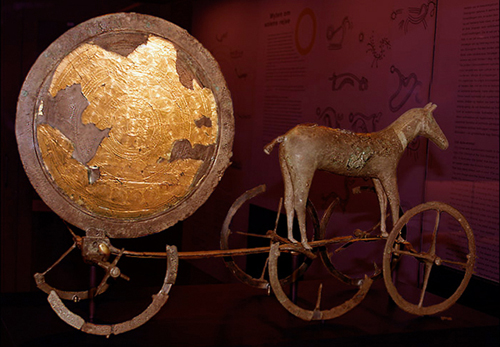
| | Solvognen er et dansk nationalklenodie - et enestående bronzealderfund udformet i bronze og guld.
Solvognen er dateret til ca. 1.350 f. Kr. men blev først fundet i 1902 i Odsherred, Nordsjælland.
Solvognen er udstillet på Nationalmuseet i København. |
Solvognen er et dansk nationalklenodie - et enestående bronzealderfund udformet i bronze og guld. Solvognen er en hulstøbt figur, bestående af en hest, der trækker en solskive. Hesten og skiven står på resterne af seks hjul, og både hest og skive har øskener, hvori liner engang var trukket imellem dem. Solskiven er belagt med guld, hvorpå fine mønstre i cirkelformede motiver er markeret.
Fundet i 1902
Solvognen blev fundet den 7. september, 1902 i Trundholm Mose i Odsherred, Nordsjælland, i forbindelse med den første pløjning af området. Finderen, Frederik Willumsen, hjembragte fundet, og lod sønnen lege med hesten i den tro, at figuren bare var et stykke gammelt legetøj. Solvognen var dog beskadiget allerede i bronzealderen, da den blev efterladt - sandsynligvis som offergave i mosen. I 1998 fandt man samme sted med metaldetektor flere fragmenter af de seks hjul på figuren.
Datering og verdensbillede
Figuren er dateret til ældre bronzealder - ca. 1350 f.Kr.
Solvognen bringer os vidnesbyrd om bronzealderens religion. Solen var da det centrale i religionen. Bronzealderens mennesker forestillede sig, at solen blev transporteret over himlen om dagen. Om morgenen førte en fisk solen til et skib, som transporterede solen indtil middag. Her tog solhesten over og førte solen videre til eftermiddagsskibet. Til aften førte en slange solen til underverdenen, der lå under den flade jord. Hernede var solen mørk, mens den blev transporteret på natskibe tilbage til morgenens udgangspunkt, hvor fisken atter tog over. Således blev dagens cyklus opretholdt i al evighed af solens hjælpere - fisken, hesten, slangen og skibene.
Forside og bagside
Solvognens begrebsverden støttes af flere helleristninger samt dekorationer på rageknive (1100 - 500 f.Kr.). Den forgyldte solskive på solvognen sidder, så man ser vognen bevæge sig fra venstre mod højre. Den modsatte side af solvognen mangler den forgyldte solskive - det er den mørklagte sol om natten på vej tilbage fra højre mod venstre til sit startsted ved solopgang. Solvognen illustrerer dermed, med sine to forskellige sider, solens bevægelse i løbet af et døgn.
Både på helleristningerne og på rageknivene trækker hesten solen i en line. Hjulene på solvognen hører således ikke til fortællingen. Hjulene er påsat for, at solskiven og hesten ved rituelle ceremonier kunne køres frem og tilbage og gengive solens bevægelser.
Kaul, Flemming: "Solvognen - Solbilledet fra Trundholm", Naturens Verden, nr. 8/1999, vol. 82, side 34-40.

Solvognens forside | 
Solvognens bagside |
Bronzelurerne
Til bronzealderens mest pragtfulde genstande hører også bronzelurerne. Disse har man fundet flere steder, og det virker som om, de er blevet anvendt to og to. Nationalmuseet i København har verdens største samling af disse musikinstrumenter.
På Rådhuspladsen i København kan man se monumentet: Lurblæserne; rejst som en gave fra Carlsbergfontet i anledning af 100 års dagen for brygger J.C. Jacobsens (1811-1887) fødsel.
Søjlen er tegnet af Palace Hotels arkitekt Anton Rosen.

Bronzelurerne | 
Rådhuspladsen i København |
Jernalderen
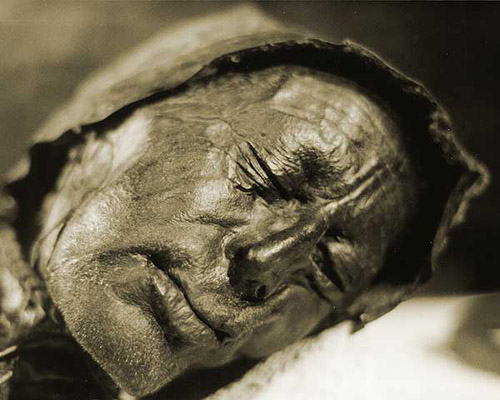
| | Jernalderen strækker sig fra ca. 500 f.Kr. frem til ca. 1100. Periodens sidste del betegnes også som vikingetiden.
Velbevarede moselig fra perioden giver os et godt billede af, hvordan tidens mennesker så ud. |
Indledning
Jernalderen strækker sig fra ca. 500 år f. Kr. til 1103 e. Kr. Jernet afløste efterhånden bronzen som redskaber og våben og i modsætning til bronzen var det ikke nødvendigt at importere jern. Det lader sig udvinde af myremalmen i de danske moser. Myremalm findes i hele Danmark, men især i de vestjyske hedeegne, den del af landet, som ikke var dækket under den sidste istid.
Periodens fra ca. 700 betegnes som vikingetiden, og hvornår denne slutter, er der delte meninger om. Den svenske middelalderarkæolog Sven Rosborn argumenterer i 2007 således: ”År 1103 er imidlertid i den seneste tid fremhævet som et logisk årstal, eftersom det var det år, at ærkesædet for hele Norden blev etableret i Lund. Tidligere pegede man på 1050 eller 1066 som vikingetidens afslutning, men der er ingen vigtige hændelser i disse årstal, der har spillet nogen nævneværdig rolle i Norden.”
Selv om hele perioden kaldes for jernalderen, bør man ikke glemme, at jern sikkert var et dyrbart råmateriale. Først ved jernalderens afslutning blev jernfremstillingen øget i et sådant omfang, at materialet fik en mere almen anvendelse.
Kontakter med romerriget
Allerede omkring tidspunktet for Kristi fødsel fandtes der mange kontakter mellem germanerne i det nordlige Europa og det vældige romerrige. Romernes ekspansion nordpå ledte imidlertid til stridigheder.
Ca. 100 år e. Kr. var nogle af de germanske folkeslag, kimbrer og teutoner – muligvis bosiddende i Jylland - begivet sig sydpå i store skarer. Denne udvandring er det først kendte af de såkaldte ”folkevandringer”. Mange flere skulle dog følge efter, dog først nogle århundreder senere.
Grænsebevogtningerne
Under romernes ekspansion nordpå havde floderne Rhinen og Donau spillet en stor rolle. Her udviklede romerne nemlig et grænsebevogtningssystem, de såkaldte ”limes”, med befæstede støttepunkter. I Domitianus regeringstid (81-96 e.Kr.) udgjorde disse limes en uendelig lang vej kantet med vagttårne i træ. Et halvt sekel senere var trætårnene erstattet med stentårne og i begyndelsen af 200-tallet, blev der anlagt jordvolde og voldgrave rundt om støttepunkterne.
Mere end tusind vagttårne og ca. 100 kasteller eller borge er lokaliseret langs denne grænse gennem hele Nordeuropa.
Arkæologiske fund ved Ystad og Kristianstad
Både i Danmark og i Skåne kan arkæologerne bekræfte datidens kontakter med romerriget. To grave i Skåne er f.eks. helt unikke i den forbindelse. I Öremölla i Skivarp nordvest for Ystad stødte man allerede i 1800-tallet på en grav, som bl.a. indeholdt en stor romersktilvirket bronzekedel. Den døde var kremeret i sin ringbrynje, der sammen med resterne af knoglerne, var lagt ned i kedelen. Desuden havde han fået romersktilvirkede glas og våben af jern med sig på sin sidste lange færd.
Et lignende pragtfund er gjort af nutidige arkæologer fra Regionsmuseet i Kristianstad. Ved udgravningen af en jernaldergravplads i Farlöv nord for Kristianstad stødte man på en bronzekedel fra ca. 200 år e. Kr., fyldt med brændte knogler stammende fra to mænd. En nærmere analyse af kedlen viser, at der er tale om romersk importvare.
Udover de kremerede knoglerester indeholdt kedlen de to krigeres våben. Grupperet således: to sværd, to lansespidser, to spydspidser, to såkaldte ”skjolbuckler”, som i datiden var placeret midt i skjoldene, sammen med to skjoldhåndtag, to par sporer samt to små menneskefigurer udfærdiget af tynde bronzeplader.
En krigerrigsk tid
Sydskandinavien er særdeles rigt på fund fra jernalderen. Specielt perioden mellem 200 f. Kr. til 400 e. Kr. tyder på en særdeles barsk og blodig tid. Her er der gjort store offerfund indeholdende våben og andre former for krigsudstyr, ikke mindst i Jylland.
Offerfund i søer og moser
De mange våben og krigsudstyret er krigstrofæer fra besejrede modstandere, som eftertiden er stødt på i søer og moser. Det antages, at de besejrede soldaters våben og udstyr er en slags taknemmelighedsoffer; skænket til guder vi ikke kender i dag. Sejrherrerne har dog sikret sig mod fjendtlig indstillede personers genbrug ved først at have gjort våbnene og de andre genstande ubrugelige. Sværdene er krøllet sammen, spydspidserne er knækket og kunstneriske udsmykninger er molesteret.
Bemærkelsesværdigt for disse store offerfund er, at der ikke i denne sammenhæng er fundet levn af mennesker. De ulykkelige mennesker, der har båret våbnene og den øvrige krigsudrustning, har åbenbart fået deres banesår et andet sted eller ført bort som slaver.
Våbengravene
I mange jernaldergrave har man fundet våben. I Skåne har man således gjort 43 våbenfund fra jernalderen. Der kan her nævnes en gravplads i Simris på Österlen og en på Albäcksbakken vest for Trelleborg. Sidstnævnte ligger direkte ud til stranden ved Østersøen, og er en af de største gravpladser fra jernalderen i Skåne. I tre af gravene blev der fundet våben f.eks. spydspidser og lansespidser.
Gravpladsen ved Simris består af 102 grave. Heraf er de seks våbengrave med lansespidser, spydspidser og sværd. Våbengravene ved Simris er langt rigere på gravgaver end dem, der er udgravet i Albäcksbakken. I en af gravene fandt man f.eks. et skjold og sporer samt håndtag til drikkebægre og keramik.
Andre fund
Beslægtet med jernalderens våbengrave kan man nævne andre righoldige fund i Skåne. I Fulltofta og i Sösdala, midt i Skåne, er man stødt på rester efter nedgravede sølvbeslag til hesteudrustninger fra 400-tallet. Sösdalafundet består af knapt tre hundrede smådele, der har indgået i udsmykningen på to hestehovedremme og mindst fem sadler. Genstandene er bevidst ødelagte og arrangeret på en måde, som er sammenlignelige med datidens traditioner i Centraleuropa.
Nede i Europa
Rytterfolket, hunnerne, invaderede store dele af Europa i årerne 375 e. Kr – 451 e. Kr. En række offerfund efter hunnerhøvdinge fra denne tid præsenterer os for præcist det samme uforståelige og destruktive billede af ødelæggelser og nedgravning af hesteudrustningsdetaljer, som blev fundet i Sösdala og i Fulltofta. Dette kan ikke være tilfældigt. Fundene i Skåne tyder på, at der i datiden har været tætte forbindelser til Centraleuropa; forbindelser af så dybtgående karakter, at de har sat sig spor i de religiøse sæder og begravelsesskikke.
Måske har ”danskerne” været stærkt repræsenteret i datidens internationale grupperinger? Måske har en del af den mere evntyrlystne del af de unge mænd været tjenestegørende hos hunnerne og hjembragt nogle af deres traditioner?

Menneskeofring | 
Dyreofring | 
Jernaldergravplads | 
Albäcksbacken | 
Lejre miljø |
Moselig
Moserne i Jylland har vist sig at indeholde en hel del moselig fra den ældste jernalder og frem til lige efter Kristi fødsel. De særlige opbevaringsforhold har bevaret disse oldtidsmennesker for os og med hjælp fra den nyeste viden inden for en række videnskaber, får vi stadigvæk ny viden om vores tidlige forfædre.
Huldremosekvinden er fundet i en mose på Djursland i Jylland 1879. Dateringen er stadig lidt usikker, men man mener, hun er lagt i mosen omkring 55 år. e.Kr Især tøjet er velbevaret; hun var iført et skindslag af fåreskind og et skørt vævet af naturfarvet uld. Liget har i mange år været gemt bort i Nationalmuseet i Københavns magasiner.
I tørvemoserne andre steder i Jylland har man i begyndelsen af 1950erne fundet flere særdeles velbevarede lig fra den ældste jernalder ca. 3-400 f.Kr. Internationalt kendt er især Tollundmanden - måske det bedst bevarede oldtidsmenneske i verden. Han er så livagtig at se på, at politiet i Silkeborg var de første, der blev alarmeret, da fundet blev gjort. Det er en mand på ca. 30 år mand, der bar tydelige spor af at være hængt. Årsagen til dette kender vi ikke. Måske en ofring til guderne? Tollundmanden ligger udstillet på Silkeborg Museum.
Tæt ved Tollundmanden fandt man endnu et lig, Grauballemanden. Han var fra samme tid, men havde fået halsen skåret over fra øre til øre. Grauballemanden er udstillet på Moesgaard Museum i Århus.
I 1938 fandt man Ellingkvinden. Hun var ca. 25 år og var, som Tollundmanden, hængt. Hendes frisure er den bedst bevarede frisure fra jernalderen. Bemærkelsesværdig er en fletning på næsten en meter, der var oprullet i nakken på hængningstidspunktet.

Huldremosekvinden | 
Tollundmanden |
Litterære kilder
Om Tacitus`s Germania
Vi har skriftlige kilder fra omkring år 0. som beretter om en række forhold i Nordeuropa. Skribenterne repræsenterer dog alle Middelhavskulturen, hvilket betyder, at det er et temmelig ensidet billede, vi får af germanerne. Tacitus store værk ”Germania” er en ofte citerede kilde. Vi skal her kun citere fra afsnittet om gæstfriheden:
”At udelukke nogen fra sin boplads anses som respektløst; hver germaner modtager, alt efter muligheder, sin gæst med et veldækket bord. Når hans forråd er opbrugt, bliver han, som nylig var vært, til en guide og følgesvend til andre og uden invitation går de til næste hus. Det gør ingenting. De modtages med samme hjertelighed. Ingen gør forskel på en nær bekendt og en fremmede, når det gælder gæstfrihed. Det er normalt at give den ankomne gæst, hvad han ønsker, og vil man gengælde med en gave modtages denne kun med en vis tøven.”
Men hvordan ser disse paradisiske forhold ud, når man sammenligner med arkæologernes offerfund og våbengrave, som jo antyder en nok så hård tid?
Om Beowulfkvadet
Først med det såkaldte Beowulfkvad møder vi en litterær kilde, hvor forfatteren nærmere kan knyttes til de oprindelige forhold i Sydskandinavien.
Forfatteren er dog ukendt, men teksten handler meget om danerne. Beowulfkvadet indeholder f. eks. beretninger som med rimelig sandsynlighed kan knyttes til virkelige hændelser. Kvadet anses som et bemærkelsesværdigt værk i den tidligste engelske litteratur. Takket være Beowulfs farbror, Hygelak, mener visse forskere, at man kan koble Beowulfkvadet sammen med kendte årstalshændelser. Hygelak kan nemlig være identisk med med den geatiske eller gautiske konge, som blev besejret og dræbt et sted mellem 515-525 e.Kr. under et krigstogt mod den frankiske kyst.
Slægtrelationerne omkring helten Beowulf er bemærkelsesværdigt detaljerede og strækker sig over flere generationer. Beowulf var søn af høvdingen Eggtheow. Hans mor var datter af gauternes kong Hredel og hans farbror var Hygelak.
Beowulfkvadet er grupperet om tre heltegerninger, som Beowulf var involveret i.
-Med sine gauter sejler han til danerne for at befri dem for udyret Grendel, som hærger i danerkongen Hrodgars store gildehal.
-Den anden kamp er imod Grendels mor, et frygteligt vidunder
-Beowulfs sidste kamp står mod en grum drage, der vogter på en stor skat. Det er bl.a. i denne afslutning, hvor Beowulf dræber dragen, og, skønt selv dødeligt såret, sidder og ser både fremad og tilbage i historien, at der dukker en mængde interessante informationer op. Vores helt er bekymret for, hvad der skal ske efter hans død. Vil frankerne og friserne hævne sig på grund af Hygelaks voldsdåd? Også svearna kan tænkes at hævne sig i forbindelse med Hygelak. Imellem svear og gautar havde der nemlig været udkæmpet store slag og et nærmere venskab lå ikke lige for.
I Beowulfkvadet nævnes en række folk: Gauterna bor i Vädermark, og når Beowulf stævner ud for at udføre sine heltegerninger, er det mod vestdanerne han styrer skibet. I kvadet omtales også Hrodgar, som østdanernes drot. I kampen mod Gredel står norddanerne udenfor gildehallen og lytter til kamplarm og våbenraslen indenfor. I digtet bliver det også nævnt, at Beowulfs far i sine unge år måtte flygte fra gautarnes land til syddanerne.
Det tyder altså på, at danerne har været opdelt i en række grupperinger. Det store spørgsmål, som altid stilles i forbindelse med dette litterære værk, er imidlertid: Hvor boede det gautiske folk? Hvem var disse gautara? At det dårligt kan tænkes at være väst- og östgotere længere oppe i Sverige fremgår af, at man altid færdedes over havet i kontakt med dette folk. Er gauter da lig med gotlændinge? Muligvis, men det virker usandsynligt, at disse skulle føre krig mod friserne og frankerne i Nordsøen på den anden side af Jylland. Derimod kunne Jylland godt svare til de beskrivelser af gautarnas land Vädermark, som nævnes i kvadet.

Beowulf |
Eksterne links om oldtiden

| | Linkikonet åbner for hjemmesider, hvor der kan findes yderligere oplysninger om oldtiden. En del af disse tilbyder også en engelsk version eller resumé. |
|